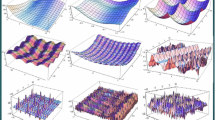Abstract
The increasing importance of nonlinear programming software requires an enlarged set of test examples. The purpose of this note is to point out how an interested mathematical programmer could obtain computer programs of more than 120 constrained nonlinear programming problems which have been used in the past to test and compare optimization codes.
Similar content being viewed by others
References
Schittkowski, K.,Randomly Generated Nonlinear Programming Test Problems, Proceedings of the 9th IFIP Conference on Optimization Techniques, Warsaw, Poland, 1979; Springer-Verlag, New York, New York, 1979.
Schittkowski, K.,A Numerical Comparison of 13 Nonlinear Programming Codes with Randomly Generated Test Problems, Numerical Optimization of Dynamic Systems, Edited by L. C. W. Dixon and G. P. Szegö, North-Holland Publishing Company, Amsterdam, Holland, 1980.
Betts, J. T.,An Accelerated Multiplier Method for Nonlinear Programming, Journal of Optimization Theory and Applications, Vol. 21, No. 2, 1977.
Colville, A. R.,A Comparative Study on Nonlinear Programming Codes, IBM, New York Scientific Center, Report No. 320–2949, 1968.
Himmelblau, D. M.,Applied Nonlinear Programming, McGraw-Hill Book Company, New York, New York, 1972.
Bracken, J., andMcCormick, G. P.,Selected Applications of Nonlinear Programming, John Wiley and Sons, New York, New York, 1968.
Huang, H. Y., andAggarwal, A. K.,A Class of Quadratically Convergent Algorithms for Constrained Function Minimization, Journal of Optimization Theory and Applications, Vol. 16, No. 5/6, 1975.
Dembo, R. S.,A Set of Geometric Programming Test Problems and Their Solutions, Mathematical Programming, Vol. 10, No. 2, 1976.
Miele, A., Huang, H. Y., andHeideman, J. C.,Sequential Gradient-Restoration Algorithms for the Minimization of Constrained Functions, Ordinary and Conjugate Gradient Versions, Journal of Optimization Theory and Applications, Vol. 4, No. 4, 1969.
Miele, A., Cragg, E. E., Iyer, R. R., andLevy, A. V.,Use of the Augmented Penalty Function in Mathematical Programming Problems, Part 2, Journal of Optimization Theory and Applications, Vol. 8, No. 2, 1971.
Miele, A., Tietze, J. L., andLevy, A. V.,Comparison of Several Gradient Algorithms for Mathematical Programming Problems, Rice University, Aero-Astronautics Report No. 94, 1972.
Hock, W., andSchittkowski, K.,Test Examples for the Solution of Nonlinear Programming Problems, Part 1, Preprint No. 44, Institut für Angewandte Mathematik und Statistik, Universität Würzburg, Würzburg, Germany, 1979.
Bus, J. C. P.,A Proposal for the Classification and Documentation of Test Problems in the Field of Nonlinear Programming, Design and Implementation of Optimization Software, Edited by H. J. Greenberg, Sijthoff and Noordhoff, Alphen aan den Rijn, Holland, 1978.
Hock, W., andSchittkowski, K.,Test Examples for the Solution of Nonlinear Programming Problems, Part 2, Preprint No. 45, Institut für Angewandte Mathematik und Statistik, Universität Würzburg, Würzburg, Germany, 1979.
Author information
Authors and Affiliations
Additional information
Communicated by A. Miele
Rights and permissions
About this article
Cite this article
Hock, W., Schittkowski, K. Test examples for nonlinear programming codes. J Optim Theory Appl 30, 127–129 (1980). https://doi.org/10.1007/BF00934594
Issue Date:
DOI: https://doi.org/10.1007/BF00934594




